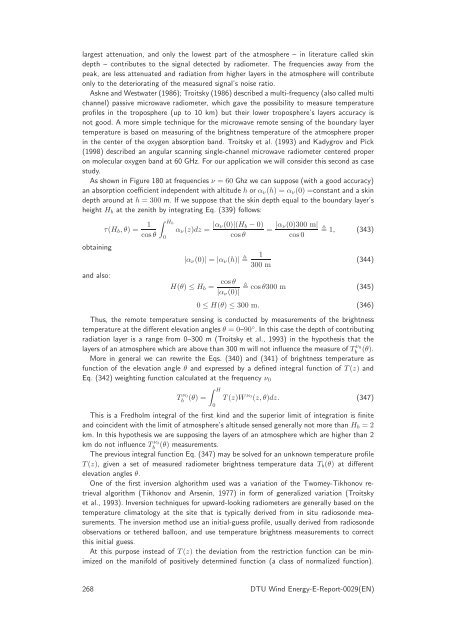Publishers version - DTU Orbit
Publishers version - DTU Orbit
Publishers version - DTU Orbit
You also want an ePaper? Increase the reach of your titles
YUMPU automatically turns print PDFs into web optimized ePapers that Google loves.
largest attenuation, and only the lowest part of the atmosphere – in literature called skin<br />
depth – contributes to the signal detected by radiometer. The frequencies away from the<br />
peak, are less attenuated and radiation from higher layers in the atmosphere will contribute<br />
only to the deteriorating of the measured signal’s noise ratio.<br />
AskneandWestwater(1986);Troitsky(1986)describedamulti-frequency(alsocalledmulti<br />
channel) passive microwave radiometer, which gave the possibility to measure temperature<br />
profiles in the troposphere (up to 10 km) but their lower troposphere’s layers accuracy is<br />
not good. A more simple technique for the microwave remote sensing of the boundary layer<br />
temperature is based on measuring of the brightness temperature of the atmosphere proper<br />
in the center of the oxygen absorption band. Troitsky et al. (1993) and Kadygrov and Pick<br />
(1998) described an angular scanning single-channel microwave radiometer centered proper<br />
on molecular oxygen band at 60 GHz. For our application we will consider this second as case<br />
study.<br />
As shown in Figure 180 at frequencies ν = 60 Ghz we can suppose (with a good accuracy)<br />
an absorption coefficient independent with altitude h or αν(h) = αν(0) =constant and a skin<br />
depth around at h = 300 m. If we suppose that the skin depth equal to the boundary layer’s<br />
height Hb at the zenith by integrating Eq. (339) follows:<br />
obtaining<br />
and also:<br />
τ(Hb,θ) = 1<br />
cosθ<br />
Hb<br />
0<br />
αν(z)dz = |αν(0)|(Hb −0)<br />
cosθ<br />
|αν(0)| = |αν(h)| 1<br />
300 m<br />
= |αν(0)300 m|<br />
cos0<br />
1, (343)<br />
(344)<br />
H(θ) ≤ Hb = cosθ<br />
cosθ300 m (345)<br />
|αν(0)|<br />
0 ≤ H(θ) ≤ 300 m. (346)<br />
Thus, the remote temperature sensing is conducted by measurements of the brightness<br />
temperature at the different elevation angles θ = 0–90◦ . In this case the depth of contributing<br />
radiation layer is a range from 0–300 m (Troitsky et al., 1993) in the hypothesis that the<br />
layers of an atmosphere which are above than 300 m will not influence the measure of T ν0<br />
b (θ).<br />
More in general we can rewrite the Eqs. (340) and (341) of brightness temperature as<br />
function of the elevation angle θ and expressed by a defined integral function of T(z) and<br />
Eq. (342) weighting function calculated at the frequency ν0<br />
T ν0<br />
b (θ) =<br />
H<br />
0<br />
T(z)W ν0 (z,θ)dz. (347)<br />
This is a Fredholm integral of the first kind and the superior limit of integration is finite<br />
and coincident with the limit of atmosphere’s altitude sensed generally not more than Hb = 2<br />
km. In this hypothesis we are supposing the layers of an atmosphere which are higher than 2<br />
km do not influence T ν0<br />
b (θ) measurements.<br />
The previous integral function Eq. (347) may be solved for an unknown temperature profile<br />
T(z), given a set of measured radiometer brightness temperature data Tb(θ) at different<br />
elevation angles θ.<br />
One of the first in<strong>version</strong> alghorithm used was a variation of the Twomey-Tikhonov retrieval<br />
algorithm (Tikhonov and Arsenin, 1977) in form of generalized variation (Troitsky<br />
et al., 1993). In<strong>version</strong> techniques for upward-looking radiometers are generally based on the<br />
temperature climatology at the site that is typically derived from in situ radiosonde measurements.<br />
The in<strong>version</strong> method use an initial-guess profile, usually derived from radiosonde<br />
observations or tethered balloon, and use temperature brightness measurements to correct<br />
this initial guess.<br />
At this purpose instead of T(z) the deviation from the restriction function can be minimized<br />
on the manifold of positively determined function (a class of normalized function).<br />
268 <strong>DTU</strong> Wind Energy-E-Report-0029(EN)

















